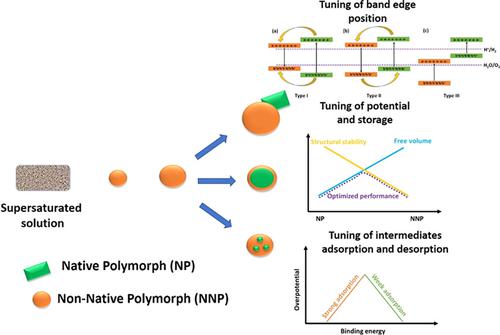当前位置:
X-MOL 学术
›
WIREs Energy Environ.
›
论文详情
Our official English website, www.x-mol.net, welcomes your
feedback! (Note: you will need to create a separate account there.)
Stabilization of non‐native polymorphs for electrocatalysis and energy storage systems
Wiley Interdisciplinary Reviews: Energy and Environment ( IF 5.4 ) Pub Date : 2020-08-23 , DOI: 10.1002/wene.389 Sulay Saha 1 , Prashant Kumar Gupta 1, 2 , Raj Ganesh S. Pala 1, 3
Wiley Interdisciplinary Reviews: Energy and Environment ( IF 5.4 ) Pub Date : 2020-08-23 , DOI: 10.1002/wene.389 Sulay Saha 1 , Prashant Kumar Gupta 1, 2 , Raj Ganesh S. Pala 1, 3
Affiliation

|
Evolution in material centric devices like batteries and electrocatalytic reactors have predominantly been made possible via the exploitation of the thermodynamic ground state of pristine or defective bulk crystal, referred to as the “Native polymorph” (NP) here. A significant increase in the material search space is possible by utilizing “Non‐Native polymorphs (NNP),” which are materials that have different translational symmetry with respect to NP. As the NNP have a distinct coordination structure from that of the NP, critical material properties can be anticipated to be different, making NNP a potential substitute material for the aforementioned applications, which are the focus of this review. To obtain a structure–function relationship, systematic approaches to the synthesis of NNP has been demonstrated. Following certain generalities behind NNP, we classify synthesis techniques into few categories with the hope of rationalizing the underlying mechanism of these synthesis and stabilization strategies. We discuss the utility of NNPs in the context of electrochemical water electrocatalytic reactions. Typically, the NNPs have more open volume space enabling lower lithium‐ion diffusion barrier, higher lithium‐ion binding energies, thereby making NNP efficient in the context of energy storage material. However, NNP have lesser stability than the NP and methods to calibrate and improve the stability of NNP are important. Overall, the discussion of polymorphic materials by demarcating them as NP and NNP provides a systematic approach towards modulating material properties as a trade‐off between thermodynamics and kinetics of physicochemical processes. Finally, the challenges and perspectives in this emerging field are discussed.
中文翻译:

用于电催化和能量存储系统的非天然多晶型物的稳定化
通过利用原始的或有缺陷的块状晶体(在此称为“天然多晶型物”(NP))的热力学基态,可以使诸如电池和电催化反应器等以材料为中心的装置的发展成为可能。通过使用“非天然多晶型物(NNP)”,可以大幅增加材料的搜索空间,这些材料相对于NP具有不同的翻译对称性。由于NNP具有不同于NP的配位结构,因此可以预期关键材料的性能会有所不同,从而使NNP成为上述应用的潜在替代材料,这是本综述的重点。为了获得结构-功能关系,已经证明了合成NNP的系统方法。遵循NNP背后的某些一般性,我们将合成技术分为几类,希望合理化这些合成和稳定策略的潜在机制。我们讨论了电化学水电催化反应中NNPs的效用。通常,NNP具有更大的开放空间,从而可以实现更低的锂离子扩散势垒,更高的锂离子结合能,从而使NNP在储能材料中变得高效。但是,NNP的稳定性低于NP,因此校准和改善NNP稳定性的方法很重要。总体而言,通过将多态材料划分为NP和NNP来进行讨论,提供了一种系统的方法来调节材料的性能,作为热力学和物理化学过程动力学之间的权衡。
更新日期:2020-08-23
中文翻译:

用于电催化和能量存储系统的非天然多晶型物的稳定化
通过利用原始的或有缺陷的块状晶体(在此称为“天然多晶型物”(NP))的热力学基态,可以使诸如电池和电催化反应器等以材料为中心的装置的发展成为可能。通过使用“非天然多晶型物(NNP)”,可以大幅增加材料的搜索空间,这些材料相对于NP具有不同的翻译对称性。由于NNP具有不同于NP的配位结构,因此可以预期关键材料的性能会有所不同,从而使NNP成为上述应用的潜在替代材料,这是本综述的重点。为了获得结构-功能关系,已经证明了合成NNP的系统方法。遵循NNP背后的某些一般性,我们将合成技术分为几类,希望合理化这些合成和稳定策略的潜在机制。我们讨论了电化学水电催化反应中NNPs的效用。通常,NNP具有更大的开放空间,从而可以实现更低的锂离子扩散势垒,更高的锂离子结合能,从而使NNP在储能材料中变得高效。但是,NNP的稳定性低于NP,因此校准和改善NNP稳定性的方法很重要。总体而言,通过将多态材料划分为NP和NNP来进行讨论,提供了一种系统的方法来调节材料的性能,作为热力学和物理化学过程动力学之间的权衡。











































 京公网安备 11010802027423号
京公网安备 11010802027423号